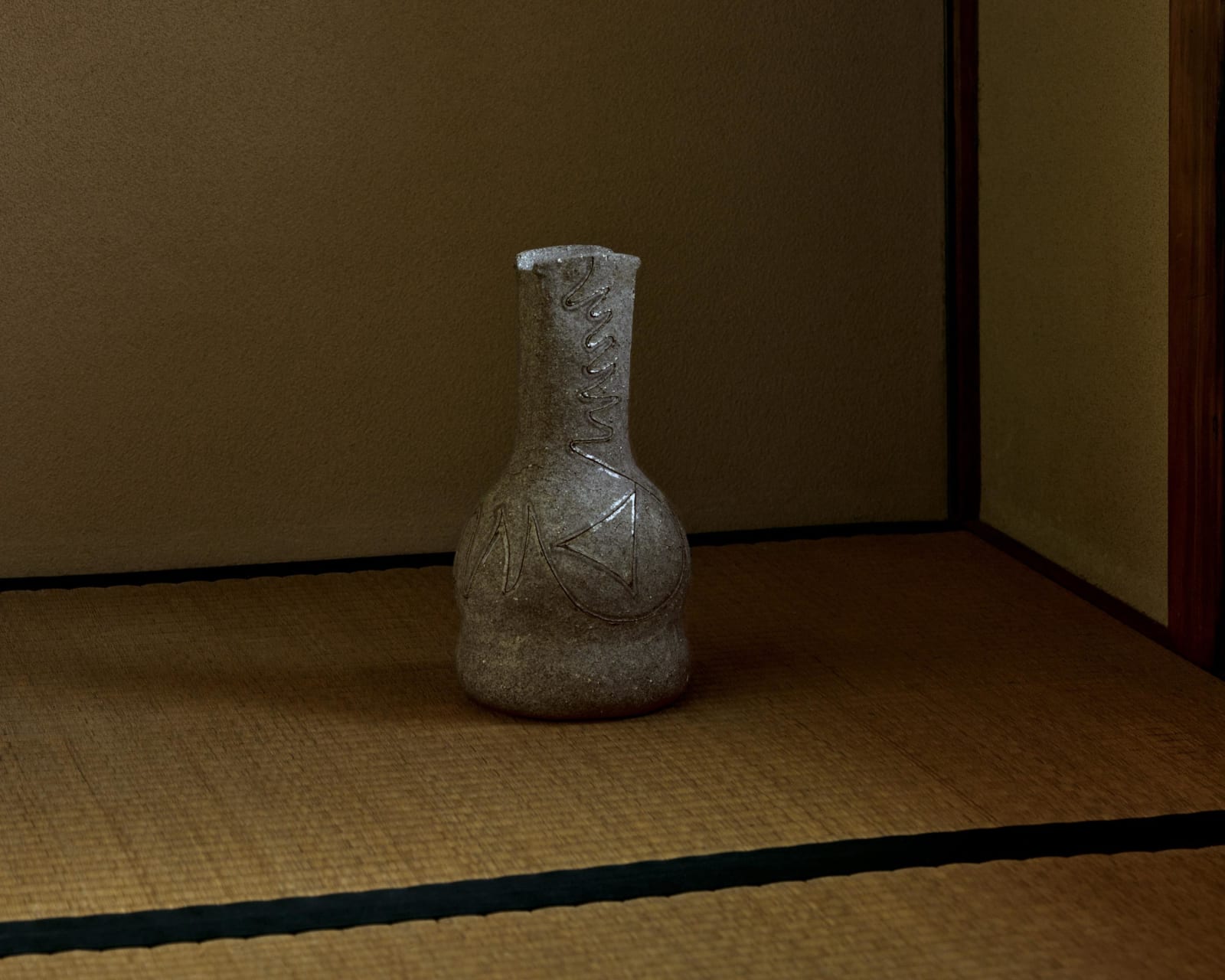Kamoda Shōji (1933–1983)
Jar
Stoneware
Incised “1974 Sho” on the bottom
1974
With a certificate of authenticity by Toobi, a box signed by the artist (1974)
W16.9 x H30.5 cm
Further images
It is a well-established fact that Kamoda Shoji from his thirties onward has continued to drastically change his style from year to year and from one exhibition to the other. In particular since 1969, when he opened his kiln in Tono, Iwate Prefecture, Kamoda has experimented with curvilinear patterns that employed his own unique firing methods, introducing an approach of sharp linear patterns carved into the surface of the object and combining this with various methods of applying colors. Hence, from his thirties to forties, Kamoda’s activities give proof of an overflowing creative imagination and physical energy that in its intensity is astonishing, sometimes even shocking to the viewer.
Made in 1974 in the midst of this creative whirlwind, the present work’s characteristic feature is a serpentine, incised line that runs from the top of the straight and upright neck, extending into a wide curve as if responding to the plumpness of the vessel’s body, only to undergo another sudden change when abruptly bending down to form a sharp apex, traveling over the surface of the ash-grey jar seemingly at will. Along this incised line there are lines of grayish-blue and grayish-green glazes (in thinly applied areas they appear grayish with a slight yellow tint). The mouth is of a rectangular shape, with its short sides pressed a little below the longer sides.
This style, where Kamoda would also incise his name on the bottom of the vessel and inscribe the box himself, appears first in 1974, when he held a solo exhibition, the Third Kamoda Shoji Ceramics Exhibition, from May 30 to June 12 at the Minami Aoyama Green Gallery in Tokyo. This show included works with a similar construction of the mouth and incised line patterns reminiscent of the present Jar, which likely was also made for that exhibition. The process of creating ceramics always involves the possibility of accidents and mishaps resulting from a certain chance aspect that can counteract the artist’s intention up the final stages of making the work, for instance slight cracks that result from the drying and firing process. It is therefore common for ceramic artists to produce several pieces of the same type. Within Kamoda’s work, Jar also seems to belong into such a context.
Kamoda Shoji (ceramist; 1933–1983)
Ceramist, born in Osaka. Kamoda graduated from the Kyoto Municipal College of Art. He studied under Tomimoto Kenkichi and Kondo Yuzo. After working at a pottery studio, he decided to become a ceramic artist full-time. Kamoda constructed a new kiln in Tono, Iwate Prefecture, aiming for a new approach outside of tradition. He received the Ministry of Education Award for Fine Arts and the Tenth Takamura Kotaro Prize.
Made in 1974 in the midst of this creative whirlwind, the present work’s characteristic feature is a serpentine, incised line that runs from the top of the straight and upright neck, extending into a wide curve as if responding to the plumpness of the vessel’s body, only to undergo another sudden change when abruptly bending down to form a sharp apex, traveling over the surface of the ash-grey jar seemingly at will. Along this incised line there are lines of grayish-blue and grayish-green glazes (in thinly applied areas they appear grayish with a slight yellow tint). The mouth is of a rectangular shape, with its short sides pressed a little below the longer sides.
This style, where Kamoda would also incise his name on the bottom of the vessel and inscribe the box himself, appears first in 1974, when he held a solo exhibition, the Third Kamoda Shoji Ceramics Exhibition, from May 30 to June 12 at the Minami Aoyama Green Gallery in Tokyo. This show included works with a similar construction of the mouth and incised line patterns reminiscent of the present Jar, which likely was also made for that exhibition. The process of creating ceramics always involves the possibility of accidents and mishaps resulting from a certain chance aspect that can counteract the artist’s intention up the final stages of making the work, for instance slight cracks that result from the drying and firing process. It is therefore common for ceramic artists to produce several pieces of the same type. Within Kamoda’s work, Jar also seems to belong into such a context.
Kamoda Shoji (ceramist; 1933–1983)
Ceramist, born in Osaka. Kamoda graduated from the Kyoto Municipal College of Art. He studied under Tomimoto Kenkichi and Kondo Yuzo. After working at a pottery studio, he decided to become a ceramic artist full-time. Kamoda constructed a new kiln in Tono, Iwate Prefecture, aiming for a new approach outside of tradition. He received the Ministry of Education Award for Fine Arts and the Tenth Takamura Kotaro Prize.





